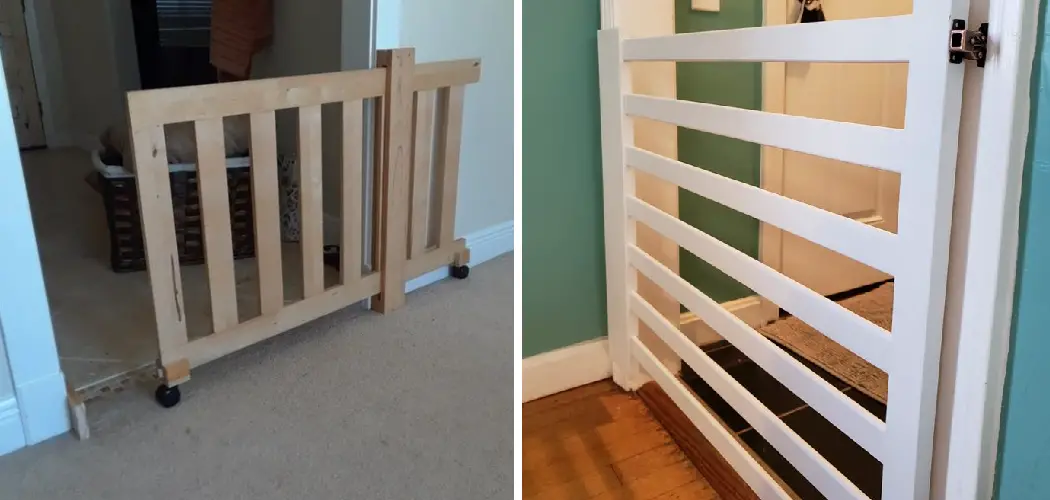If you’re a pet owner looking to keep your furry friend confined indoors, then building an indoor dog gate may just be the perfect solution. Not only will it provide a safe and secure area within which they can play or rest, but it also offers up peace of mind that your pup won’t wander off when unsupervised.
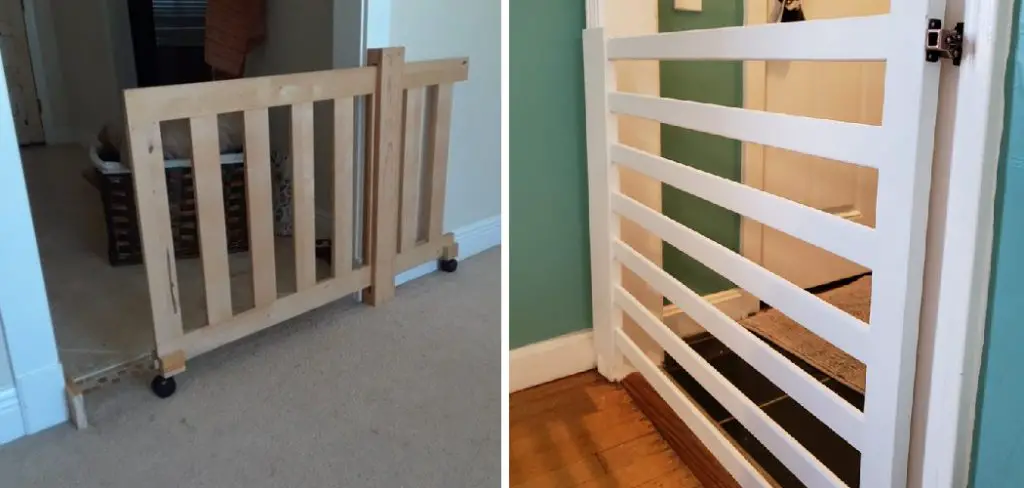
In this blog post, we’ll walk you through how to build an indoor dog gate step-by-step – from gathering materials to setting up the final product! With our helpful instructions and friendly guidance, constructing your own custom dog gate will be easier than ever. So let’s get started!
What Can I Use Instead of Dog Gate?
If you’re looking for an alternative to a dog gate, there are several options available. You could choose to use baby gates, which are easy to install and keep your pup in one room or section of a bigger area. If your pup is particularly small, then another option may be the use of a large baby playpen or an exercise pen.
These are lightweight and can be easily set up in any room of your home. Additionally, you might try using furniture to block off a space or setting up a makeshift wall by filling an area with boxes or other objects that keep your pup confined. You could even opt for invisible fences or pet gates, which provide greater control over where your pup can and cannot go. Any of these methods should help you keep your pup safe while indoors.
No matter what method of containment you choose, it’s important to remember that proper supervision is necessary with any type of containment system. If you are using a pet gate or baby gate, make sure to always check on your pup to ensure they are safe and secure. Additionally, exercise pens should never be used to contain your pup for an extended period of time.
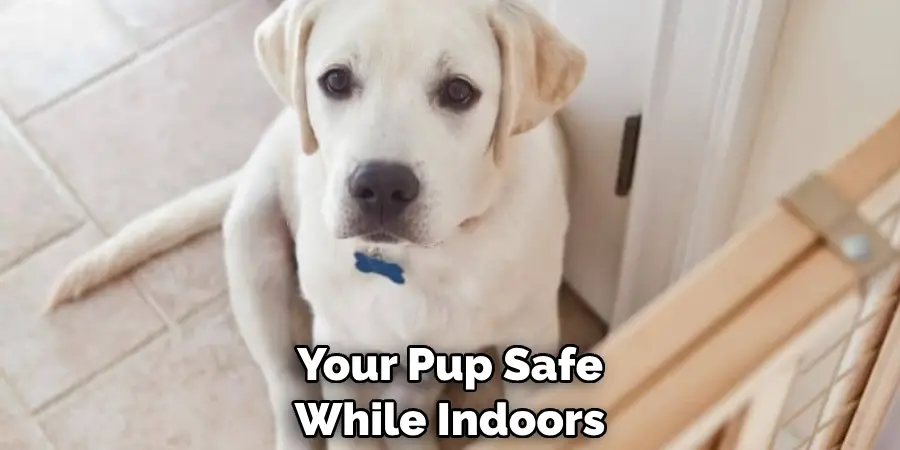
Regularly take your pup out of the containment system to give them a chance to move around, explore and go potty so they don’t experience any discomfort or distress. Furthermore, be sure to reward your pup with treats and toys to make the containment system more enjoyable and ensure your pup is happy and healthy.
By taking a few simple precautions, you can ensure that any type of containment system you use will be safe and secure for your pup. With patience and consistency, soon both you and your pup will be happier and more comfortable when separated indoors.
What Is the Best Material for a Dog Gate?
When it comes to choosing the best material for your DIY indoor dog gate, you have several options. Though wood is a classic choice and easy to work with metal and plastic are popular materials as well.
Wooden gates are strong and attractive and can be painted or stained if desired. They blend in nicely with other furniture and won’t rust like metal. Some types of wood do require more maintenance than others; for example, pine needs to be treated regularly, or it will dry out and split over time. Cedar is also a great option since it’s naturally resistant to warping, rotting, cracking, insect infestation, and weathering.
Metal gates provide extra strength and can last a long time, even with heavy use. However, they can be more expensive and may require additional hardware like nuts and bolts during the installation process. Metal gates are also available in several colors to match your decor but may rust over time if not properly maintained.
Plastic gates are lightweight, easy to work with, and inexpensive. They’re available in various colors and styles but don’t offer a lot of strength or durability to wood or metal gates.
No matter what material you choose for your dog gate, make sure it is sturdy enough to keep your pup safe while still allowing them easy access where necessary. Check that any materials used meet the required safety standards so that you can feel secure knowing your pet is safe and secure.
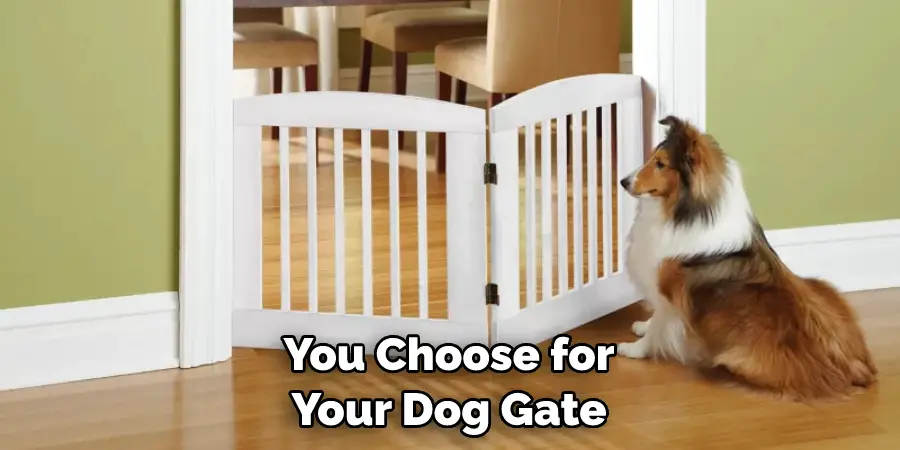
10 Methods How to Build an Indoor Dog Gate
Step 1: Determine the Gate’s Location and Purpose
Before starting the construction process, decide where you want to install the dog gate and consider its purpose. Is it to restrict access to a specific area or to prevent your dog from entering certain rooms? This initial step will help you determine the gate’s size and style.
If you are installing a gate to keep your dog out of the kitchen, for example, a gate that swings open and closed or one with a pet door may be the best option. At the same time, a gate with a latch may be more suitable for blocking off stairs or other areas.
Though the exact size of the gate will ultimately depend on your pet’s breed and size, a general rule of thumb is to measure 4-6 inches taller than the height of your dog.
Step 2: Measure the Opening
Accurate measurements are crucial for building a properly fitting dog gate. Measure the width and height of the opening where you intend to install the gate. Take precise measurements, ensuring that the gate will fit securely. It’s also important to measure the distance from the floor to the top of the opening, and consider any door trim or baseboards that may get in the way of a proper fit.
Make sure to double-check your measurements before cutting any wood or drywall. Although a gate can be placed on the floor, many homeowners prefer to mount it slightly higher. For added convenience and safety, consider mounting your dog gate at least 6 inches above the floor.
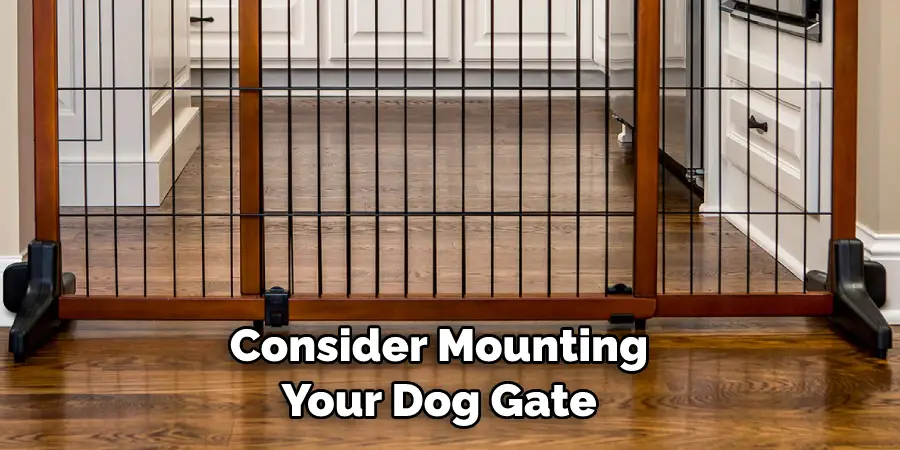
This will prevent your pup from jumping over or pushing it down. To mount the gate higher, make sure you have enough clearance between the top of the opening and the ceiling.
Step 3: Select the Material
Choose the material that best suits your needs and preferences. Common materials for indoor dog gates include wood, PVC pipe, mesh fabric, or repurposed items. Consider factors such as durability, ease of maintenance, and aesthetic appeal when making your selection. Wood is an attractive choice and can be customized to fit any space.
PVC pipes are lightweight, easy to clean, and very sturdy. Mesh fabric is a great choice for larger dog gates, as it provides visibility and airflow. Repurposed items such as shelving units or bookshelves can be an affordable option. Whichever material you choose, make sure it is strong enough to withstand the weight and pressure of your dog.
Step 4: Design the Gate
Based on your measurements and chosen material, sketch out the design of your dog gate. Consider whether you want a simple frame gate, a decorative barn door gate, a folding gate, or any other style that suits your home decor.
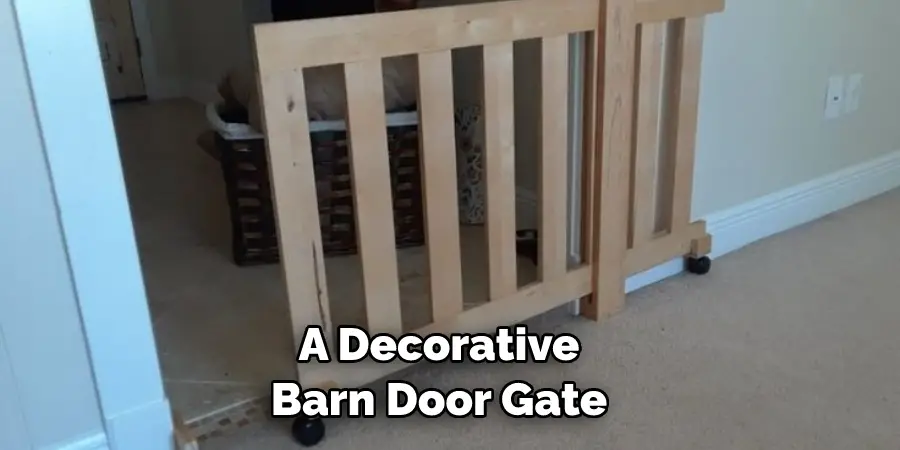
Make sure to include the measurements and materials needed in your design. Although you can make changes to the design as needed, having a plan in place helps ensure that your gate will fit properly and look great.
If you are not comfortable with designing the gate yourself, there are many resources available online with detailed instructions and templates that can help. Additionally, you can always hire a professional to help you design and build the gate. Though it can be an extra expense, having a professional ensure the gate is built correctly and safely may be worth it.
Step 5: Gather the Materials and Tools
Once you have your design finalized, gather all the necessary materials and tools. This may include wood planks, hinges, latch, screws, drill, saw, measuring tape, sandpaper, or any other items specific to your chosen design.
Be sure to purchase the appropriate size and number of supplies needed for the job. As always, safety comes first so make sure you have all the necessary protective equipment, such as gloves and safety glasses, before beginning the project. When you’re all set, move on to the next step.
To ensure that the project is a success, double-check that you have all the tools and materials needed. However, don’t start your project until you’re confident that you have everything you need. Finally, take some time to familiarize yourself with the tools and materials you’ll be working with. This will help ensure you have a successful build.
Step 6: Cut and Assemble the Frame
If you have chosen a wooden gate, cut the wood planks to the required dimensions for the frame. Use a saw to make precise cuts, and then assemble the frame according to your design. Use screws and a drill to secure the pieces together.
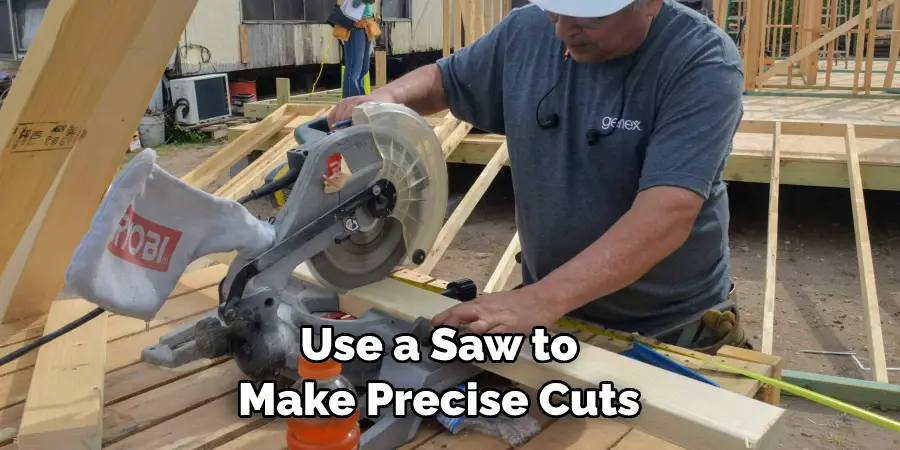
Though not necessary, you can use a bit of wood glue for extra strength. Next, attach the hinge hardware to one side of the frame and the latch hardware to the other side.
Step 7: Add Reinforcements (if needed)
Depending on the size and height of the gate, you may need to add reinforcements to ensure stability and durability. Consider adding diagonal braces or additional support to strengthen the gate, especially if you have a larger or more energetic dog.
You can also add corner blocks near the bottom of the gate to reduce movement or wiggle room. Consider adding screws or nails at each joint for additional stability. Make sure to use screws or nails that are strong enough to securely hold the gate together, but not so large that they would injure your dog if they manage to get through the gate.
Step 8: Attach Hinges and Latch
Install hinges on one side of the gate to allow for easy opening and closing. Position the hinges at a suitable height and secure them with screws. On the opposite side, attach a latch or lock mechanism to keep the gate securely closed. When choosing the latch or lock, make sure that it is secure enough to keep the gate from coming open without you unlocking it.
Make sure that your installation is sturdy and secure, as it will support the weight of your pet. Test the gate to make sure that everything is functioning correctly before allowing your pet near it. With a little bit of work and the right materials, you can easily build an indoor dog gate that will keep your beloved companion safe and secure.
Step 9: Sand and Finish the Gate (optional)
If desired, sand the surfaces of the gate to ensure a smooth finish. This step is particularly important if you have chosen a wooden gate. You can also apply a protective finish or paint the gate to match your home decor and provide added durability.
Leave the gate to dry completely before attaching the hinges and latch. Keep in mind that some materials may require multiple coats of paint or finish, so be sure to read the instructions on the product packaging carefully before continuing. Once the finish is dry, attach the hinges and latch onto the gate.
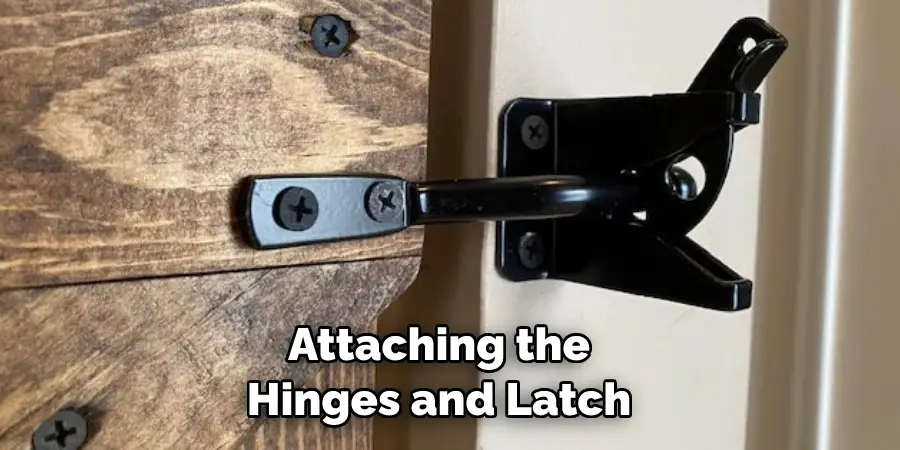
Step 10: Install the Gate
Once the gate is fully constructed and finished, position it in the desired location. Use screws or mounting brackets to secure the gate to the door frame or wall, ensuring a sturdy installation. Test the gate by opening and closing it to ensure proper functionality. If the gate swings freely and opens properly, it is ready for use. Make sure to teach your pet how to safely open and close the gate, and be sure to lock it when not in use for added security.
Conclusion
With the right tools and materials, a beautiful indoor dog gate can be built in no time. By following the step-by-step instructions outlined above, you can build your own durable and attractive pet barrier to keep your dog safely contained–while also looking good in your home. And if you are unclear on any of the steps or don’t feel like tackling this project alone, reach out to a professional contractor who can help you achieve gorgeous results.
When it comes to securing your pup at home, nothing beats building an indoor dog gate tailored just for your space and needs. Thanks for reading, and we hope this has given you some inspiration on how to build an indoor dog gate!

